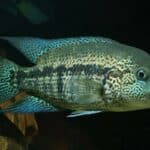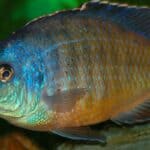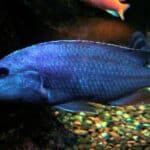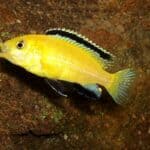Red Zebra Cichlid (Maylandia estherae) are incredibly hardy and easy fish to care for. They are ideal for aquarists who want to start with the Mbuna cichlids.
Still, they are territorial fish, which requires special care and attention when preparing the aquarium and keeping the fish.
Occurring naturally on submerged rocky shores on the East side of Africa and practically all of Lake Malawi, it is also one of the most common cichlids enjoyed by fish keeping hobbyists.
In this article, all issues involving this species and its maintenance in aquariums will be addressed and explained.

Red Zebra Cichlid Species Summary
Red Zebra Cichlid (Maylandia estherae) is a tropical freshwater cichlid species endemic to Lake Malawi in East Africa. It occurs along rocky coastlines and reef formations on the coasts of Mozambique and Malawi. These cichlids are known as Mbuna. Mbuna are fish belonging to the haplochromine family that inhabits the rocky shores of Lake Malawi. The word Mbuna means “rockfish” in the native language of the traditional communities in that region.
Considered territorial fish, they show an aggressiveness in certain situations; fights between males of this species are often violent.
They are one of the most common cichlids in the aquarium industry; this success within the aquarium can be attributed to being an easily reared fish, presenting a wide range of color diversity, and being very resistant and easy-to-feed fish.
They feed mainly on algae and biofilm in the crystal clear, hard, and alkaline tropical waters of Lake Malawi.
Care Guide
It is a hardy fish that is easy to care for, but that doesn’t exclude knowing the species, habits, and behaviors in-depth. Like any other species, the Red Zebra Cichlid has its peculiarities, addressed and detailed in the following topics.
Tank size
Even though it is not one of the most aggressive mbuna, the tank space must be well dimensioned concerning the number of inhabitants due to territorialism. For starters, a 48″ x 15″ x 12″ (35 gallons) aquarium with lots of hiding places can be used to house a trio; as they are very active fish that live among the rocks, an essential factor is the width of the aquarium due to the hardscape.
Tankmates
The choice of tank mates is an essential step towards the success of an African cichlid aquarium due to its territoriality and aggressiveness. Red Zebras should be kept with other types of Mbuna of similar size, avoid more peaceful species, which will only passively suffer aggression.
A technique widely used in African cichlid maintenance is tank overcrowding, making it difficult for the animals to form territory, dispersing, and reducing aggression between tank mates. Avoid placing other fish territories that inhabit the middle zone.
Red Zebra Cichlids usually inhabit the bottom of the aquarium, although they are present throughout the water column; therefore, avoid keeping bottom fish. Most fish that inhabit the upper part of the tank’s water column will not compete for territory with the Red Zebra Cichlid, making it a healthy choice.
Same Species Tanks
It has a certain degree of aggressiveness like most mbunas, but its hostility is more directed towards males of the same species and other fish of similar colors. It is commonly kept in the same species tank.
It would be best if you had a large volume aquarium, as well as keep many females. Keeping a male with several females is a common practice to reduce harassment over just one female. If you want to keep more than one male per tank, having an aquarium above 80 gallons with many rock caves and hiding places is recommended.
The crucial point is the gender balance; always keep the male in a harem with a minimum of 3 females per male.
Water Parameters
Red Zebra Cichlids are resistant fish, able to withstand different physicochemical parameters of water, but that doesn’t mean that we should keep them in hostile environments.
In terms of ideal conditions (which every aquarist looks for to keep his fish), the tank must have a stable and constant temperature between 75 and 82 degrees. Avoid soft and acidic water conditions, which would be ideal for South American cichlids.
This African cichlid species can tolerate water with a more neutral pH, but it lives better when the water is tending towards the alkaline side; its ideal pH is between 7.6 and 8.4, and the hardness at 10-25°H.
Use precision equipment and tests to gauge and regulate your aquarium’s parameters correctly.
What to Put in Their Tank
As for any other aquatic animal, the heater and a filter are essential to keep the tank with Red Zebra Cichlid healthy. The substrate must be soft and without sharp edges to facilitate the excavations made by them and avoid accidents; sandy substrates are ideal.
To provide territories and hiding places for the animals, add rocks grouped in aquascaping, thus forming different caves of different sizes. The stones must be carefully buried and supported against each other; as the fish dig, there is a risk of cave-ins, a fish could get stuck, or rock could hit the glass. Don’t forget to keep areas open for animals to swim.
The most important thing to maintain in a Mbunas aquarium is the rocks and caves, along with the easily excavated substrate. The stones will provide several places for each fish to form and protect their territory and use as a hiding place in case of aggression by a dominant male.
Common Diseases
Red Zebra Cichlid is a highly resistant fish, but like all Mbuna, they are subject to Malawi bloat. Malawi bloat is a sporadic pathological condition in African ornamental cichlids. This pathological condition is not restricted to Lake Malawi African Cichlids but extends to other families members.
High levels of total ammonia, mainly non-ionized ammonia, present in the water of African cichlid aquariums are among the foremost necessary conditions that lead to Malawi bloat. The combination of high temperatures and high pH (a peculiar condition existing in African cichlid aquariums) requires monitoring of ammonia levels in the water.
There is also debate about too much animal protein contributing to Malawi bloat since African cichlids have more herbivorous food habits and a high demand for vegetables in their diet.
The direct cause of Malawi bloat is bacteria. Malawi bloat is a systemic bacterial infection originating from a proliferation of bacteria in the intestinal tract. Ammonia in water and inadequate nutrition is not the direct cause, but these are factors / conditions that predispose a bacterium to cause bloat. Among the main bacteria causing Malawi bloat are the genus Aeromonas mobile and Clostridium.
Food and Diet
In nature, Red Zebra Cichlids feed mainly on algae and biofilm (Biofilm is a biological system composed of algae, bacteria, and invertebrates, commonly known as Periphyton or Aufwuchs) on rocks and substrate. When kept in an aquarium, they will readily accept virtually any type of food offered as they are gluttonous.
Offer seaweed-based feeds like spirulina and provide fresh foods like Nori seaweed.
In a natural environment, they can feed on some insects in the rainy season; because of this, rations with animal protein can be administered, however, very sparingly; use them only once a week or every 15 days in small amounts to avoid Malawi Bloat.
Newborn fish that are found are also part of their diet.
In addition, they also feed on plankton from the water column. In aquariums, they must be provided with a specific food, with a diet rich in vegetable matter.
Lifespan
Get ready to enjoy the company of this colorful cichlid for a long time because when in captivity, they can live up to 10 years, with the average being around seven years.
In nature, these animals live less, as they are predisposed to attacks from other animals and environmental causes.
Appearance
It has a robust and wide body with a hydrodynamic shape. Red zebra cichlids (Maylandia Estherae) have an excellent range of colors; males are usually light blue, females beige brown or reddish-orange, with no wide vertical bars on the body.
Size
In a natural environment, Konings (1993) took the maximum mean of the collected animals and established the mean sizes of 7.9 cm (3.11″) in wild males and 6.3 cm (2.4″) in females. In aquarium animals, we can measure 13 cm (5.4″) for males and 10 cm (4″) for females.
Behavior and Temperament
Their behavior is identical to most Mbunas, which means they become aggressive among the same species and with other fish of similar color patterns. While evils can be territorial, they would be considered mid-level aggression for a mbuna, tending towards the lower aggression side, but still a pretty robust fish. Their behavior is identical to most Mbunas, which means they become aggressive between the same species and others with similar color patterns.
Breeding
The Red Zebra Cichlid is a maternal mouth incubator species; after spawning and fertilization, the mother keeps the eggs in her mouth.
The whole process starts with the male digging the substrate of a part of his territory; after that, he will show himself to the female and swim behind her, the two will swim in circles. In the ritual, the female lays egg by egg on the ground, the male fertilizes it, and the female will then pick up the eggs with her mouth and keep them safe until they hatch.
After ten days, the eggs hatch, but the female will protect them in her mouth for another 15 days. At the end of the incubation period, the fry is released, fully formed, and self-sufficient to seek their food. The number of eggs per hatch depends on the size of the female and is usually between 15 and 30.
As in the case of cichlids that spawn on substrates, buccal incubators have also developed a way to keep the oxygenation of eggs high; they do this by sucking water through their mouths, while the females take the opportunity to rotate them, increasing oxygenation even more.
The period between spawning and the release of the chicks usually takes around 21 to 30 days; after spawning occurs, you can choose two alternatives, either if you leave the female in the aquarium or transfer her to another where she will not suffer any stress.
After the incubation period, if the female takes too long to release the chicks naturally, a technique called “stripping fry” can be used to remove the chicks from the mother’s mouth by the aquarist. After the fry release, it is advised to separate the female and reinforce her feeding for a few days until she recovers well.
Gender Differences: Male vs. female
The male has the anal and dorsal fins with the finest tips, resembling the shape of a “V,” their colors are more powerful, and their body is more prominent. Some may have a bluish color over the body or just the fins (which females do not have).
The female can be reddish/orange or “blurred,” The dorsal and anal fins are more rounded at the tips, resembling a “U.”
Many mouth-brooding cichlids have markings called egg spots. These are brightly colored spots on the anal fin; male and female red zebras have these markings. Evaluating the amount and shape of egg spots on the fins to determine the sex in this species is not safe, as egg spots are more correlated with dominance within the group than with sex; therefore, you should not take it into account. For example, dominant females may have more color dots than subdominant males.
Some Red Zebra Cichlid males are blue, while females are orange. However, depending on locality, orange and OB (“orange blotch”) males and yellow or OB females also exist. Size, color, and behavior are the best ways to correctly sex animals.
Fun Facts
As a result of its popularity, robustness, and ease in reproducing this species, we see entirely degenerate variants in the trade that has nothing to do with wild Red Zebra Cichlids.
We see females of the most varied colors, from white to bright orange (almost red), as we see blue, orange, pale yellow, and nearly white males. What is even more absurd is that they are cataloged as being different species, or they are called “Red Zebra” or “Blue Zebra” and are no more than “mixtures” between geographic varieties of the species.
The zebra is called mbuna because it lives close to rocks. Its scientific name has undergone some changes since its discovery; it was called Pseudotropheus zebra, Pseudotropheus estherae, and some still call it Metriaclima estherae. In addition to orange (red), “blurred” and bluish varieties are the most common, but there are several others, such as albino, black dorsal, cobalt, blurred blue, golden, among others. Try not to keep with other fish of the same gender and similar appearance to avoid the risk of fights and hybridizations.
The discussion between the name Maylandia estherae and Metriaclima estherae has been going on for some time; the defenders of the name Metriaclima argue that Maylandia is just a name given in honor of a person (Hans Mayland) and that it does not describe any characteristic of the fish, another argument is that typically names given in glory should be used in the specific epithet and not in the genus.
The first Red Zebra Cichlid appeared in the hobby community around 1973 and has since been a hit with hobbyists. Due to the political situation at the collection sites, until the 1990s, only the Red and Orange variants were found. With political stability, other populations began to be collected, with different colors appearing as a matrix to form new strains for aquarium.
References
Konings, A., 1990. Ad Konings’s book of cichlids and all the other fishes of Lake Malawi. T.F.H. Publications, Inc. 495 p.
Konings, A., 1995. Description of Pseudotropheus estherae sp. nov., the well-known red zebra cichlid from Lake Malawi. Tropical Fish Hobbyist (May 1995):206-210.







